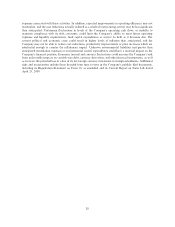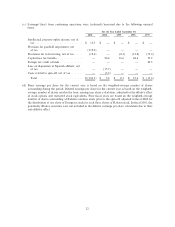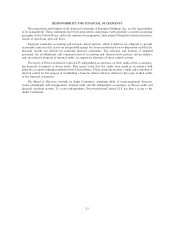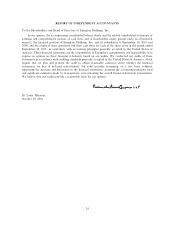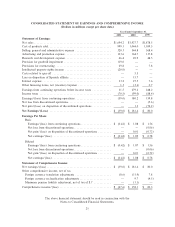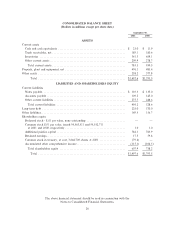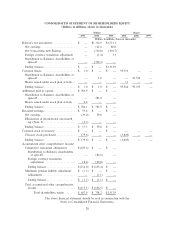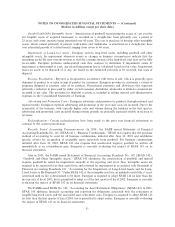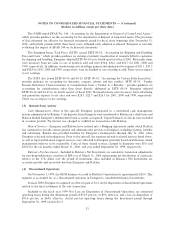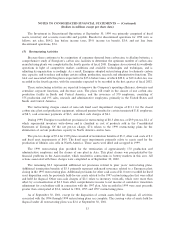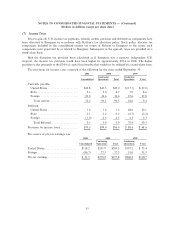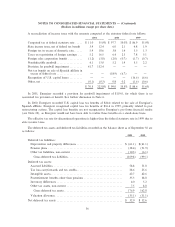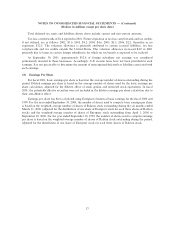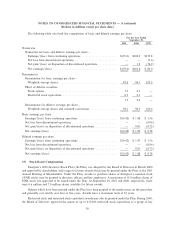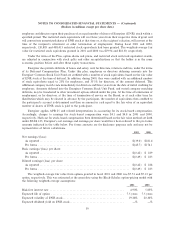Energizer 2001 Annual Report Download - page 33
Download and view the complete annual report
Please find page 33 of the 2001 Energizer annual report below. You can navigate through the pages in the report by either clicking on the pages listed below, or by using the keyword search tool below to find specific information within the annual report.NOTES TO CONSOLIDATED FINANCIAL STATEMENTS Ì (Continued)
(Dollars in millions except per share data)
statements, and the reported amounts of revenues and expenses during the reporting period. Actual results
could diÅer from those estimates.
Foreign Currency Translation Ó Financial statements of foreign operations where the local currency is the
functional currency are translated using end-of-period exchange rates for assets and liabilities and average
exchange rates during the period for results of operations. Related translation adjustments are reported as a
component within accumulated other comprehensive income in the shareholders equity section of the
Consolidated Balance Sheet.
For foreign operations where the U.S. dollar is the functional currency and for countries that are
considered highly inÖationary, translation practices diÅer in that inventories, properties, accumulated depreci-
ation and depreciation expense are translated at historical rates of exchange, and related translation
adjustments are included in earnings. Gains and losses from foreign currency transactions are generally
included in earnings.
Financial Instruments and Derivative Securities Ó Energizer uses Ñnancial instruments in the manage-
ment of foreign currency and interest rate risks that are inherent to its business operations. Such instruments
are not held or issued for trading purposes.
Foreign exchange (F/X) instruments, including currency forwards, purchased options and zero-cost
option collars, are used primarily to reduce transaction exposures associated with anticipated intercompany
purchases and intercompany borrowings and, to a lesser extent, to manage other transaction and translation
exposures. F/X instruments used are selected based on their risk reduction attributes and the related market
conditions. The terms of such instruments are generally 12 months or less.
For derivatives not designated as hedging instruments for accounting purposes, realized and unrealized
gains or losses from F/X instruments are recognized currently in selling, general and administrative expenses
or other Ñnancing items, net in the Consolidated Statement of Earnings. Energizer has not designated any
Ñnancial instruments as hedges for accounting purposes in the three years ended September 30, 2001.
Energizer adopted Statement of Financial Accounting Standards No. 133, ""Accounting for Derivative
Instruments and Hedging Activities'' (SFAS 133), and Statement of Financial Accounting Standards
No. 138, an amendment of SFAS 133, in the Ñrst quarter of Ñscal 2001. The implementation of this standard
did not have a material eÅect on its consolidated Ñnancial position or results of operations.
Cash Equivalents Ó For purposes of the Consolidated Statement of Cash Flows, cash equivalents are
considered to be all highly liquid investments with a maturity of three months or less when purchased.
Inventories Ó Inventories are valued at the lower of cost or market, with cost generally being determined
using average cost or the Ñrst-in, Ñrst-out (FIFO) method.
Capitalized Software Costs Ó Capitalized software costs are included in Other Assets. These costs are
amortized using the straight-line method over periods of related beneÑt ranging from two to seven years.
Property at Cost Ó Expenditures for new facilities and expenditures that substantially increase the useful
life of property, including interest during construction, are capitalized. Maintenance, repairs and minor
renewals are expensed as incurred. When property is retired or otherwise disposed of, the related cost and
accumulated depreciation are removed from the accounts, and gains or losses on the disposition are reÖected
in earnings.
Depreciation Ó Depreciation is generally provided on the straight-line basis by charges to costs or
expenses at rates based on the estimated useful lives. Estimated useful lives range from three to 30 years for
machinery and equipment and three to 50 years for buildings. Depreciation expense was $58.6, $57.9 and
$68.4 in 2001, 2000 and 1999, respectively.
30


